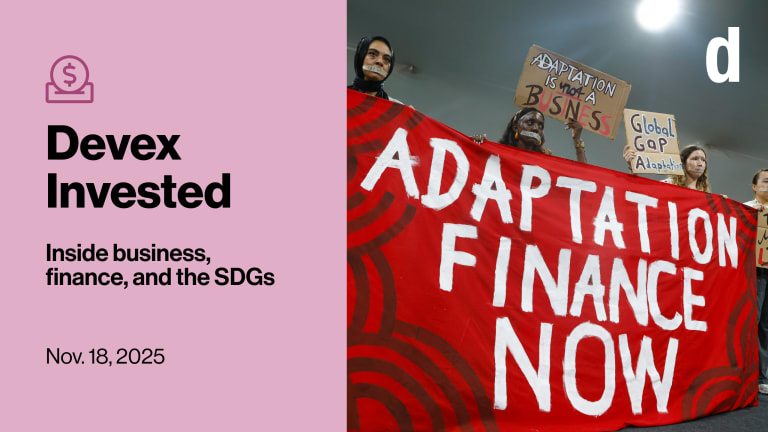
There’s a lot at stake at COP 29 — the major U.N. climate conference taking place in Baku, Azerbaijan, later this year — not least of which is setting a new climate finance target.
Setting the goal last time didn’t exactly translate to meeting it, and this time around, most agree that the previous target of $100 billion a year for lower-income countries will hardly meet mounting needs.
(On that point, Devex has a recent analysis showing how much climate finance is going to the most vulnerable countries. In 2022, some $115.9 billion was spent by developing economies.)
This is a preview of Devex Invested
Sign up to this weekly newsletter to get the insider brief on business, finance, and the SDGs in your inbox every Tuesday.
A meeting of delegates in Baku last week evidently made little progress toward a new target. The main sticking points were the amount of money and who will be responsible for contributing to it, writes Devex contributor Tais Gadea Lara.
“The discussions are still stuck in that developed countries continue to refuse to discuss quantitative proposals, effectively holding a number of crucial topics hostage to get what they want on the contributor base,” Iskander Erzini Vernoit, director at the IMAL Initiative for Climate and Development, tells Tais.
What do they want? For more countries that are lower-income but have a greater responsibility for greenhouse gas emissions — such as China — to contribute. But delegates from some of those countries, including India, point out that the 2015 Paris climate agreement says that high-income countries are responsible for providing financial resources.
Also at issue is whether or not the loss and damage fund agreed last year will be included in the target — if not it would be at risk “of becoming an empty shell,” CAN International says in a statement.
While there’s a long road to an agreement and questions about the size of delegates’ ambitions, the COP 29 organizers are still optimistic they can get there. The COP 29 Azerbaijani presidency is “committed to agreeing” on the new collective quantified goal on climate finance, its CEO Elnur Soltanov says.
Also promised: finalizing a provision of the Paris agreement related to high integrity carbon markets, Devex contributor Stéphanie Fillion reports.
Read: Latest global climate finance goal talks ‘still stuck’ on dollar amount
Also: COP 29 presidency ‘committed’ to agree on climate finance goal, CEO says
Data dive: What climate finance is flowing to the most vulnerable countries? (Pro)
+ Not yet a Devex Pro member? Start your 15-day free trial today to access all our expert analyses, insider insights, funding data, exclusive events, and more. Check out all the exclusive content available to you.
Dearth of data
In order to effectively tackle climate change, good data about what’s needed will be important. But a recent report from the Asian Development Bank found that only 17 of its 49 member countries are collecting climate data in some form. That is in a region that contributes about 50% of global carbon emissions, a share which could rise as emissions drop elsewhere.
Part of the challenge is that countries don’t have the resources they need — human or financial — to collect the relevant data, Devex contributor Disha Shetty writes. Countries need to identify what data should make up the core indicators that their national statistics offices should prioritize and then equip those agencies with the skills and systems they need to collect the information, Disha writes.
While ambition and collecting granular data “might seem daunting,” it’s “really feasible given existing data resources,” Albert Park, ADB’s chief economist, says.
Read: The Asian Development Bank wants more granular climate data in region
Price of malnutrition
Nutrition is about more than hungry people or undernourished children — it should also be considered as an economic data point, according to the Gates Foundation’s eighth annual Goalkeepers report out today.
“Nutritional deficits quickly translate into financial deficits,” the report says. Just how big? $3 trillion a year in productivity is lost because people’s physical and cognitive abilities are stunted by undernutrition, my colleague Tania Karas writes.
One key to tackling the challenge? A new UNICEF-led fund, inspired by the Global Fund to Fight AIDS, Tuberculosis and Malaria, that’s aimed at scaling up ways to address malnutrition in women and children (and improve coordination on nutrition interventions).
The Child Nutrition Fund has a goal to raise $2 billion by 2030 to support 350 million children — and has raised nearly $270 million so far, including $70 million from the Gates Foundation, which helped to set it up.
“We’re actually hoping to have some active discussions at the U.N. General Assembly and others with key funders,” the foundation’s CEO Mark Suzman said to reporters. “That’s money that can come in right now and scale up interventions right now, in real time.”
Read: Gates Foundation sounds the alarm on the crisis of child malnutrition
+ Join us for Devex @ UNGA 79 on Sept. 25-26 for a series of live interviews, networking moments, and conversations on key global challenges, including development funding shortages and food insecurity. Register now to join us in New York or online.
What we’re reading
Big banks pressed to stop financing livestock production over climate concerns. [Agriculture Dive]
The African debt dilemma: Unpacking the three unfavorable factors. [ODI]
Zimbabwe creditors mull debt-for-climate swaps as part of the restructure of $21 billion in arrears. [Bloomberg]








